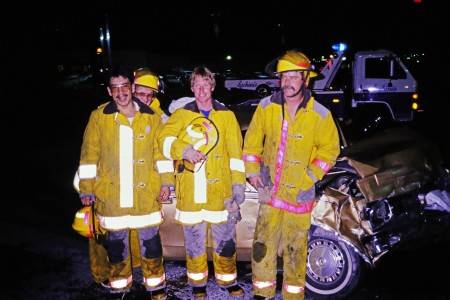SPINAL IMMOBILIZATION
ALL LEVELS
You may elect to withhold spinal restriction and discontinue all spinal stabilization efforts if your patient meets ALL of the following criteria. Criteria includes seated patients when considering use of KED. Proceed immediately with spinal stabilization if patient fails to meet ANY of the following:
1. Patient Reliability:
a. Conscious, alert, and well oriented, not under suspicion or the influence of drugs, alcohol, or any other mind-altering substance.
b. Legal adult or emancipated minor and has no language or communication problems.
c. No suspicion of other major distracting injury.
d. No suspicion of head/brain injury.
2. Assess Spinal Column:
a. The best study on clearing the C-spine and other spinal injuries has the following criteria for clearance in the field:
a. The patient has no neck pain.
b. The patient’s neck is not tender to firm palpation.
c. The patient has no numbness, tingling, weakness or other neurologic symptoms in the extremities.
d. The patient does not have a painful injury elsewhere that could distract them from recognizing their neck pain.
e. The patient is alert and competent and not impaired by alcohol, drugs, head trauma, or other impairing conditions.
3. Assess Sensory and Motor Function:
a. No sensory deficit.
b. No motor deficit
If the patient fails the above criteria place a C-collar and:
If ambulatory assist to stretcher
If non-ambulatory use rigid extrication device as needed to move patient to stretcher and then remove device if possible.
Utilize C-collar if patient is >65 y/o.
• Long spine boards (LSB) have not been shown to improve patient outcomes. The best use of the LSB is as an extrication device.
Patients should not be immobilized on a LSB, however if unconscious and/or unresponsive maintain use of LSB to aid in patient extrication.
ALL LEVELS
You may elect to withhold spinal restriction and discontinue all spinal stabilization efforts if your patient meets ALL of the following criteria. Criteria includes seated patients when considering use of KED. Proceed immediately with spinal stabilization if patient fails to meet ANY of the following:
1. Patient Reliability:
a. Conscious, alert, and well oriented, not under suspicion or the influence of drugs, alcohol, or any other mind-altering substance.
b. Legal adult or emancipated minor and has no language or communication problems.
c. No suspicion of other major distracting injury.
d. No suspicion of head/brain injury.
2. Assess Spinal Column:
a. The best study on clearing the C-spine and other spinal injuries has the following criteria for clearance in the field:
a. The patient has no neck pain.
b. The patient’s neck is not tender to firm palpation.
c. The patient has no numbness, tingling, weakness or other neurologic symptoms in the extremities.
d. The patient does not have a painful injury elsewhere that could distract them from recognizing their neck pain.
e. The patient is alert and competent and not impaired by alcohol, drugs, head trauma, or other impairing conditions.
3. Assess Sensory and Motor Function:
a. No sensory deficit.
b. No motor deficit
If the patient fails the above criteria place a C-collar and:
If ambulatory assist to stretcher
If non-ambulatory use rigid extrication device as needed to move patient to stretcher and then remove device if possible.
Utilize C-collar if patient is >65 y/o.
• Long spine boards (LSB) have not been shown to improve patient outcomes. The best use of the LSB is as an extrication device.
Patients should not be immobilized on a LSB, however if unconscious and/or unresponsive maintain use of LSB to aid in patient extrication.
